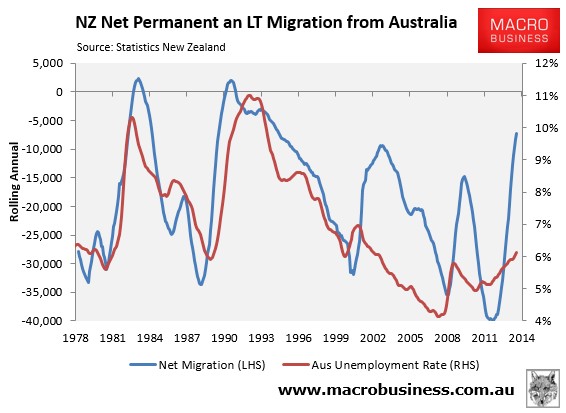
The Australian has reported today that the number of 457 skilled worker visas granted in Australia fell by 39% in the 2013-14 financial year as the labour market weakened, although the number of migrant workers already in Australia rose slightly:
The number of foreigners applying for a four-year work visa fell below 50,000 during 2013-14…
Thousands of migrant workers flocked back to their home countries during the year, triggering the cancellation of nearly 29,000 work visas…
Despite the slump in new applications, the number of migrants already working in Australia on the four-year 457 work visas crept 0.8 per cent higher last financial year to 108,870 workers.
This is good news in light of the Department of Employment’s skills shortages report, released in late-July, which revealed that the number of occupations suffering skills shortages is at an “historic low” with employers able “to recruit skilled workers without marked difficulty” and “generally large fields of applicants vying for skilled jobs and employers filling a high proportion of their vacancies”.
It also accords with the latest New Zealand immigration data, released last week, which showed that Kiwis have continued to return home as Australian unemployment has risen (see next chart).

Construction, Forestry, Mining and Energy Union national secretary Michael O’Connor, claimed the decline in job applications from migrant workers proved that labour market testing – which requires employers to advertise to locals first – was helping Australians find jobs, and recommended that it be extended to all 457 visa applications:
“Labour market testing should be extended and monitored,’’ Mr O’Connor said.
“At the moment, labour market testing can involve putting an ad on a Facebook page for five minutes.”
Indeed, back in June The Australianrevealed that only one in three of the 457 visas issued last year were subject to “labour market testing” to prove no Australian could do the job, with half of Australia’s migrant workers also recruited onshore.
In light of the deterioration in the labour market, concerns about rorting, and growing public skepticism towards skilled worker visas more generally, the Abbott Government appears to be wavering in its support of 457 visas.
In March, the Government announced a review of 457 visas, which looked as if it would reopen a loophole that would allow employers to hire an unlimited number of foreign workers under a temporary working visa, potentially opening the system to widespread rorting. Whereas now, Employment Minister Eric Abetz, insists that employers should hire “Australians first’’:
“We should be testing the job market,’’ he said. “Everybody in this government is committed to providing jobs for Australians first, if at all possible. If we do have labour shortages in certain areas it makes good sense to open up the opportunities to people from other countries but first and foremost we have an obligation to provide employment opportunities to our fellow Australians.”
As argued previously, the efficacy of allowing employers easy access to 457 visas is questionable, given: 1) the general absence of labour shortages (as revealed by the Department of Employment above); 2) unemployment is hovering around the highest level in 12 years; 3) the labour force participation rate is falling (suggesting hidden employment); and 4) there is substantial under-employment.
Moreover, with the mining investment boom set to unwind over the next few years, along with the closure of the local car industry from 2017 (if not earlier), labour surpluses are only likely to increase from today’s already high levels.
In light of these facts, the visa system should not systematically make it easier to import labour from offshore rather than training local workers, as this will only lead to a large pool of unemployed, and deprive our youth of employment opportunities.

